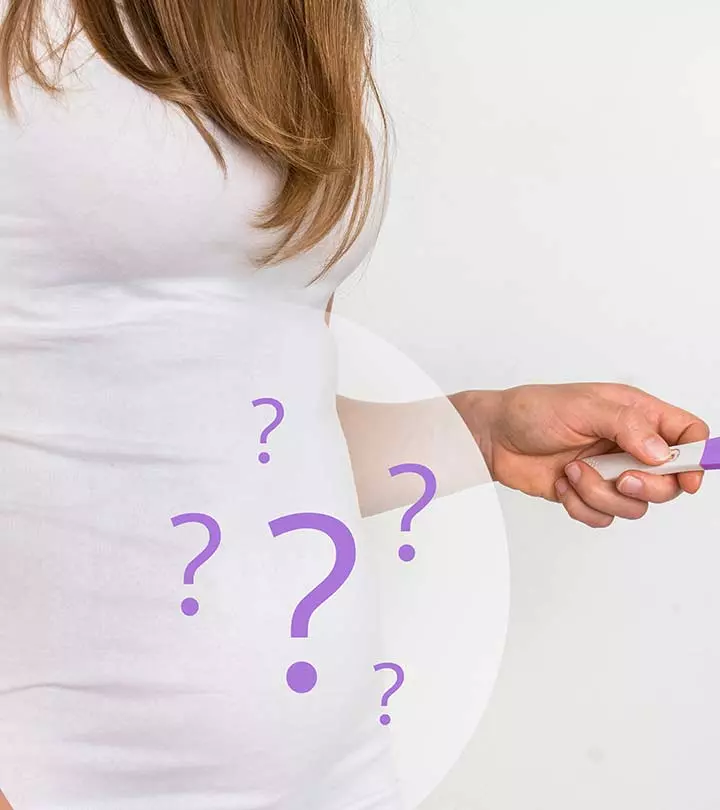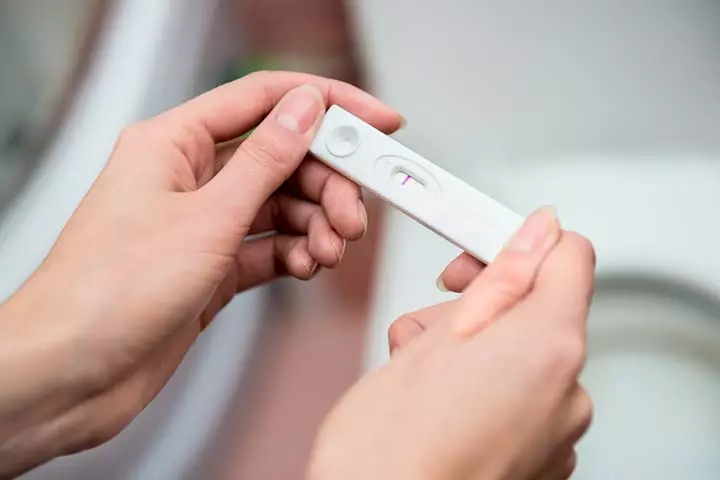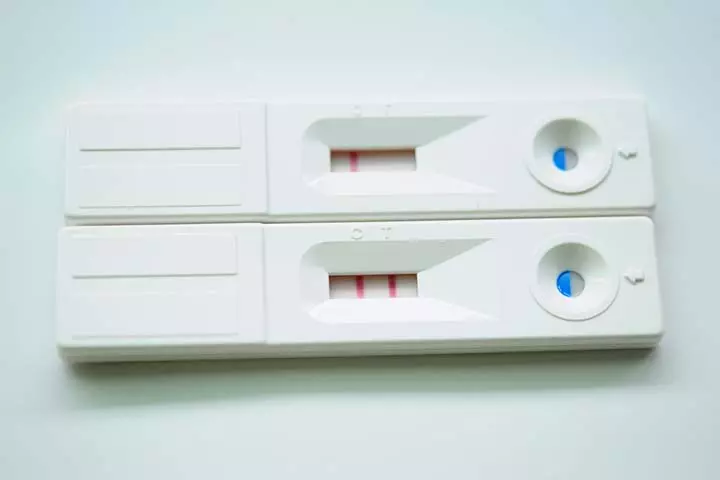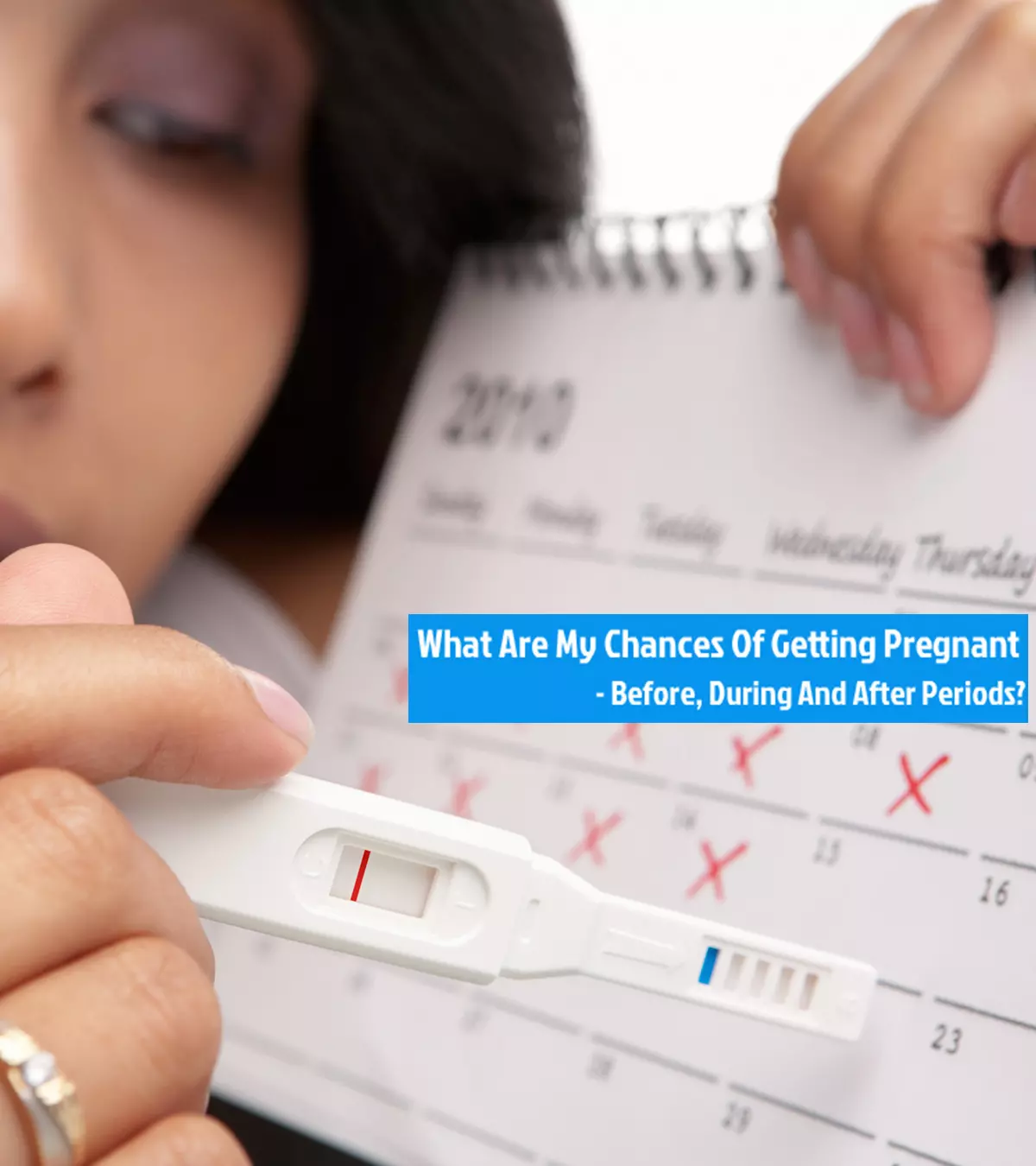
Image: iStock
Experiencing pregnancy symptoms but negative test results may be disheartening for women trying to conceive. The tests for pregnancy involve checking your blood or urine for the human chorionic gonadotropin (hCG) hormone. Home pregnancy tests detect the presence of the hCG hormoneiA hormone produced by the placenta during pregnancy to sustain the pregnancy and nourish the fertilized egg in urine. hCG is produced in the body after the implantationiThe process of the embryo finding its way through the fallopian tubes and into the uterus, where it attaches to the walls of a fertilized egg in the uterus, and its levels increase in blood and urine during the first trimester. However, these tests are not 100% accurate and may produce false-negative or false-positive results (1) (2).

Continue reading this post to learn what may cause a negative pregnancy test despite having symptoms of pregnancy.
Key Pointers
- False negative pregnancy test results can occur due to testing too early, low levels of hormones, diluted urine, delay in taking the test, or faulty test kits.
- Conditions like ectopic and molar pregnancies can cause pregnancy symptoms but negative test results.
- Premenstrual syndrome and ovulation may cause pregnancy-like symptoms due to hormonal fluctuations in the body.
- Dealing with stress and anxiety when trying to conceive can be crucial in obtaining a positive pregnancy result.
True Pregnancy With Pregnancy Symptoms But Negative Test
Urine pregnancy tests may produce false-negative results, that is, the test may show you are not pregnant while you are actually carrying a baby. This may happen due to:
1. Taking the test too early in pregnancy
The amount of hCG increases as the pregnancy progresses and may take some time to reach a level that a test is capable of detecting (3). So, the test kit may fail to detect low levels of the hormone if tested too early and show a negative result. In such a case, you can test again after a week.
Some test kits may instruct you to take the test on the day you expect your period to start. However, the FDA suggests taking a pregnancy test at home one to two weeks after a missed period to obtain the most reliable results (4).
A mother shares her story of getting a false negative pregnancy test due to testing too early, even before her expected period. “When I conceived my first child, I had this feeling that I could be pregnant. Then, I decided to go for a pregnancy test. After carrying out the test, the lab scientist approached me and told me I had a negative result. Although, I saw the look of confusion on his face that said he wasn’t so sure. “When it was time for me to have my period, I had repeated menstrual cramps for some days without getting my period. Finally, it came, but it wasn’t flowing as expected. Little did I know that it was implantation bleeding. I was a little worried but decided to see my gynecologist. After taking my medical history, he (gynecologist) told me to lie down for a physical examination. He checked me. Imagine my surprise when I got the news of ‘congratulations,’ you are two months pregnant (i).”
 Did you know?
Did you know?2. Having hormones in amounts lower than the detectable levels
Certain factors may be responsible for a low level of hCG hormone at the time of test (5) (6).
- The hCG levels may naturally vary among women with normal pregnancies, with peak and low hCG levels at different times.
- There may be an imprecise estimation of the expected day of the next menstrual periodiA monthly cycle in which a woman bleeds from her vagina , causing low levels of hCG at the time of the test.
- Testing later in the day where the hormone concentration may be affected by water intake.
3. Using A Diluted Sample

It is advised to use the first morning urine for the test as it is supposed to have the highest concentration of hCG (4). Drinking a lot of water before the test or even the night before may dilute the urine and reduce its hCG content below the detectable limit of the test.
4. Delay in taking the test
The following situations may arise if there is a delay in taking the test (7) (8).
- The mechanism of a usual positive test progresses by the sandwiching of free antibodiesiDefensive proteins produced by the immune system in response to foreign invaders such as bacteria and viruses , fixed antibodies, and the hCG molecules. If the hCG levels are too high, they separately saturate the two types of antibodies, preventing the sandwich formation known as the hook effect. This phenomenon may give a false-negative result.
- Different variants of hCG may be present later in pregnancy, and some tests may fail to detect these, showing a negative result.
5. Erroneous methods or a faulty test kit

Though the majority of the home pregnancy test kits follow similar methods, it is always advisable to read the instructions carefully before performing the test. A cohort-based study indicates that about 24% of women using home pregnancy test kits may get false negative results, with variation depending on the kit used and environmental factors (25). Not following the instructions may cause errors in the results. A particular test kit may be faulty due to manufacturing defects or improper handling and storage. Consider using a digital pregnancy test, as it minimizes the chances of misreading results and is more user-friendly than traditional line tests. Additionally, ensure that the kit is new as the results may not be reliable past the expiry date.
 Point to consider
Point to considerAshley Hicks, a vlogger and mother of three, shares her experience of having pregnancy symptoms despite negative test results, and how she chose to take additional tests. She says, “If you’re experiencing any pregnancy symptoms, I recommend taking a pregnancy test. Even if it shows negative, if you really believe that you’re pregnant, I suggest spending a little more on other tests that can detect pregnancy sooner. Dollar store tests might detect that you’re pregnant, but they don’t pick up as well as the clear blue test and that’s one of the things that I noticed.
“In two days, we went to the doctor and confirmed it. I had a lot of blood work done, and they also did a urine test and all the necessary checks. They confirmed that we were, in fact, pregnant (ii).”
Conditions Causing Pregnancy Symptoms But Negative Pregnancy Test
All fertilized eggs may not result in a healthy pregnancy and may be associated with abnormal medical conditions such as:
- Ectopic pregnancy: It is the condition where the embryo develops outside the uterus, mostly in the fallopian tubeiTube-like structures connecting the ovaries and uterus that help transport eggs for the fertilization process . Initially, you may experience pregnancy symptoms similar to a normal pregnancy with signs such as breast tenderness, missed menstrual period, or an upset stomach (9). However, since it is not a normal pregnancy, the hCG levels will be too low and will lead to a negative test result.

- Molar pregnancy: According to the American Pregnancy Association, molar pregnancies are prevalent among one in 1000 pregnancies. It is a rare condition where abnormal fertilizationiA process where a sperm cell combines with an egg cell to form a zygote causes an abnormal fetusiAn unborn offspring that develops and grows within the uterus to form. The placental tissueiA specialized tissue that forms an organ (placenta) that connects the baby to the uterus and provides oxygen and nutrients to it grows as a cellular mass inside the uterus. These benign tumor cells may release high amounts of hCG, producing a hook effect or degradation products of hCG not detectable by test kits. In both cases, a negative test result is obtained (10). A molar pregnancy may initially produce regular signs of pregnancy, such as morning sickness and sore breasts, but the pregnancy ends in a miscarriageiA natural loss of pregnancy before 20 weeks of gestation (11)
Consult a healthcare provider if you experience persistent pregnancy symptoms despite negative test results. Early medical intervention can help address underlying conditions that may require prompt attention.
Factors That May Make You Feel Pregnant When You Are Not
Hormonal fluctuations, stress, physiological changes, and certain medical conditions can cause symptoms that resemble pregnancy (1). Here are some reasons you might feel pregnant even when you are not:
1. Premenstrual syndrome
It is a group of symptoms that occur due to hormonal fluctuations before a menstrual period. The symptoms include breast swelling or tenderness, fatigue, dizziness, backaches, mood swings, and stomach discomfort that may resemble those during pregnancy (12). The hormone progesteroneiA female reproductive hormone that plays a vital role in menstruation, pregnancy, and breastfeeding is considered responsible for it (13) (14).
2. Ovulation
Similar symptoms but in milder forms may appear during the release of eggs from the ovaries (15). If the duration of your menstrual cycle varies, ovulation symptoms may be mistaken for signs of pregnancy.
 Quick fact
Quick fact3. Medications
Medications used in fertility treatments consist of hormones, such as progesterone and gonadotropinsiHormones regulating ovarian and testicular functions for sexual development , which are similar to the ones secreted by the body to initiate and maintain pregnancy. These agents may have side effects that resemble pregnancy symptoms if you are undergoing such treatments to assist fertility (16) (17).
4. Pseudocyesis
It is a rare psychosomatic disorder where a woman falsely believes she is pregnant. It manifests the signs and symptoms of pregnancy from irregular or no periods, distended abdomen, food cravings, nausea and vomiting, breast shape and size changes to even sensing fetal movements and milk secretion. Several neuronal, hormonal, and pathological conditions (tumors, cysts, or fibroids in the reproductive organs) have been found responsible (18).
Dealing With Stress When Trying To Conceive
The waiting cycle of tracking your fertile days, trying to conceive, and testing for pregnancy can become stressful. However, you must remember that stress may reduce your chances of conceiving, and it is crucial to take care of your mental well-being in addition to your physical health (19). Take care of your mental health by (20):
- Following a good lifestyle with nutritious food and moderate exercise
- Expressing your feelings to your partner, a trusted friend, or a family member
- Making time to pursue your hobbies
- Relaxing with meditation or mindfulness techniques
- Seeking medical help if you feel overwhelmed or have doubts

Frequently Asked Questions
1. What should I not do before a pregnancy test?
You should not drink large amounts of fluids before a pregnancy test as it may dilute the HCG levels in the body, making it undetectable (2).
2. How long after implantation does the test show positive?
You may observe a positive pregnancy result three to four days from implantation. But the accuracy increases to 98% by the seventh day (22).
3. Can PCOS give a false positive pregnancy test?
Yes, polycystic ovarian syndromeiA condition where the female body produces increased male hormone resulting in multiple cysts on the ovaries (PCOS) may lead to false positive home pregnancy test results as the luteinizing hormoneiHormone that stimulates ovulation in women and causes testicles to make testosterone (LH) levels remain high throughout the menstrual cycle (23).
4. Is it better to dip a pregnancy test or pee on it?
Most pregnancy test kits follow the dip or pee-on-a-stick method. The midstream or pee-on-a-stick method is accurate 99% of the time, while the dip method has an accuracy of 70% (24).
5. When should I consult a doctor if I feel pregnant but my test is negative?
If your home pregnancy test results are unclear, visit your doctor for further tests. Seeking medical advice sooner is advisable if you have spotting, bleeding, intense abdominal pain, nausea, dizziness, or a history of high-risk pregnancies or pregnancy-related complications. These signs may indicate underlying issues that need medical attention (26).
Several symptoms similar to but unrelated to pregnancy may excite you when you are planning a pregnancy. For example, nausea and vomiting may be associated with indigestion or an intestinal infection and stomach or abdominal cramping with frequent urination, a result of a urinary tract infection. Track your menstrual cycle accurately and undergo the pregnancy test at the recommended time. Two successive negative reports, one week apart, are seldom wrong. Make sure you strictly follow the instructions mentioned in the package insert. However, do not delay seeing a doctor if you continue experiencing pregnancy symptoms but have negative test results.
Infographic: Possible Reasons For A Negative Pregnancy Test
The home pregnancy test kits show reliable results when hCG reaches detectable levels. This may be a few days after implantation. Several other factors may cause pregnancy symptoms without a viable embryo. So, scroll through the infographic below to learn about the reasons for negative pregnancy tests.
Some thing wrong with infographic shortcode. please verify shortcode syntaxIllustration: Is it Possible to Have Pregnancy Symptoms But Negative Tests?

Image: Dall·E/MomJunction Design Team
Personal Experience: Sources
MomJunction articles include first-hand experiences to provide you with better insights through real-life narratives. Here are the sources of personal accounts referenced in this article.
i. Pregnant with a negative test result.https://ogwumikelovely.medium.com/pregnant-with-a-negative-test-result-d362bd64e7ff
ii. Negative Pregnancy Test Results – Still Pregnant – 4 Week Symptoms.
https://www.youtube.com/watch?v=iSvzy7vKRJk
References
- Pregnancy testing.
https://www.betterhealth.vic.gov.au/health/healthyliving/pregnancy-testing - Pregnancy Test.
https://medlineplus.gov/lab-tests/pregnancy-test/ - hCG levels.
https://www.healthdirect.gov.au/hcg-levels - Pregnancy.
https://www.fda.gov/medical-devices/home-use-tests/pregnancy - Danielle Betz and Kathleen Fane; (2025); Human Chorionic Gonadotropin.
https://www.ncbi.nlm.nih.gov/books/NBK532950/ - C. Gnoth and S. Johnson; (2014); Strips of Hope: Accuracy of Home Pregnancy Tests and New Developments.
https://www.ncbi.nlm.nih.gov/pmc/articles/PMC4119102/ - Richard T Griffey et al.; (2013); ”Hook-like effect” causes false-negative point-of-care urine pregnancy testing in emergency patients.
https://pubmed.ncbi.nlm.nih.gov/21835572/ - Flaw in many home pregnancy tests can return false negative results.
https://medicine.washu.edu/news/flaw-in-many-home-pregnancy-tests-can-return-false-negative-results/ - Premenstrual Syndrome (PMS).
https://www.acog.org/womens-health/faqs/premenstrual-syndrome - Tichaendepi Mundangepfupfu and Muhammad Waseem; (2013); Partial hydatidiform mole with false-negative urine human chorionic gonadatropin test in the emergency department.
https://pubmed.ncbi.nlm.nih.gov/24188605/ - Hydatidiform mole.
https://www.thewomens.org.au/health-information/pregnancy-and-birth/pregnancy-problems/early-pregnancy-problems/hydatidiform-mole - Premenstrual syndrome (PMS).
https://womenshealth.gov/menstrual-cycle/premenstrual-syndrome - Andrea J Rapkin and Alin L Akopians; (2011); Pathophysiology of premenstrual syndrome and premenstrual dysphoric disorder.
https://pubmed.ncbi.nlm.nih.gov/22611222/ - Pregnancy hormones: progesterone oestrogen and the mood swings.
https://www.nct.org.uk/information/pregnancy/body-pregnancy/pregnancy-hormones-progesterone-oestrogen-and-mood-swings - Ovulation signs.
https://www.pregnancybirthbaby.org.au/ovulation-and-fertility - Walter Ciampaglia and Graciela E Cognigni; (2015); Clinical use of progesterone in infertility and assisted reproduction.
https://pubmed.ncbi.nlm.nih.gov/26345161/ - Fertility Treatments for Females.
https://www.nichd.nih.gov/health/topics/infertility/conditioninfo/treatments/treatments-women - Marzieh Azizi and Forouzan Elyasi; (2017); Biopsychosocial view to pseudocyesis: A narrative review.
https://www.ncbi.nlm.nih.gov/pmc/articles/PMC5894469/ - Kristin L. Rooney and Alice D. Domar; (2018); The relationship between stress and infertility.
https://www.ncbi.nlm.nih.gov/pmc/articles/PMC6016043/ - Planning a pregnancy and managing your mental health.
https://www.tommys.org/pregnancy-information/planning-a-pregnancy/are-you-ready-conceive/managing-mental-health - Am I Pregnant, Or…?
https://americanpregnancy.org/pregnancy-symptoms/am-i-pregnant-or/ - T Chard; Pregnancy tests: a review.
https://pubmed.ncbi.nlm.nih.gov/1639991/ - Tips on getting the most from at home fertility tests.
https://fertility.womenandinfants.org/blog/tips-on-getting-the-most-from-at-home-fertility-tests - How early can home pregnancy tests show positive results?
https://utswmed.org/medblog/home-pregnancy-tests/ - B G Valanis and C S Perlman; (1982); Home pregnancy testing kits: prevalence of use, false-negative rates, and compliance with instructions.
https://pmc.ncbi.nlm.nih.gov/articles/PMC1650088/ - When to Go to the Doctor After a Pregnancy Test.
https://www.westsuburbanmc.com/when-to-go-to-the-doctor-after-a-pregnancy-test/
Community Experiences
Join the conversation and become a part of our nurturing community! Share your stories, experiences, and insights to connect with fellow parents.
Read full bio of Dr. Irene (Eirini) Orfanoudaki
Read full bio of Dr. Joyani Das
Read full bio of Rebecca Malachi
Read full bio of Reshmi Das
















